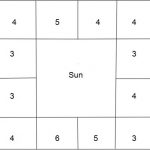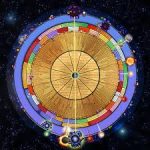The most common queries that an astrologer gets are regarding career, marriage and infertility. Though medical science has come a long way in offering advice and treatments infertility is still a major issue for some people. But even with the most modern fertility treatments, there is no guarantee of success. Astrology offers insight into all areas of life and fertility is definitely one of them.
Studying A Birth Chart For Birth Of Children
Any facet of a chart should be studied from multiple angles. Especially with major life issues such as childlessness, an imperfect superficial analysis of the chart would cause a lot of heartbreak. If there are issues with having children or childlessness all the aspects of the chart have to be gauged to arrive at a conclusion.

Generally, Rahu and Mars are considered very malefic to childbirth. Afflictions by these planets cause miscarriages and other fertility issues. This is a general thumb rule.
The Fifth House
The primary house of children is the Vedic Astrology – House 5, Putra Bhava. A good 5th house denotes happiness from progeny. However, when there are malefics in the 5th house one must study other factors of the chart as well. The lord of the 5th is then studied. If the lord of the fifth is also afflicted we can conclude that are problems with regard to children. A benefic aspect might mitigate the problem to a certain extent. Some afflictions are a combust 5th Lord, 5th Lord in the Dusthanas (6,8 or 12), 5th in the 6th house and the lord of the Lagna afflicted by Mars/Rahu.
Karaka Of The Fifth House
In Vedic astrology, one must also study the Karaka of the house to get further details. A well placed and strong Karaka could help the house. Jupiter is the Karaka for children. When a chart has issues with the 5th house or 5th lord, we study the position and strength of Jupiter.
Additionally, Jupiter is the Karaka or significator for the 5th house. If Jupiter is also afflicted the problem is compounded. Some astrologers also study the fifth house from the Karaka as well.
Fifth From The Moon
The fifth house from the Moon is also studied for troubles or afflictions to the 5th house. Jupiter is also studied in the Moon chart. One can look for similar combinations and placement as the Lagna chart.
The D7 or the Saptamsa is a critical divisional chart to view in order to ascertain the probability of children and their wellness/ futurelife. The Lagna, lagna Lord and the fifth house in the Saptamsa are important.
Presence of Rahu and Ketu, especially Ketu in key houses in the chart can also give an indication regarding children. Important to check chart and figure out the vedic match and confirm the possibility of children. This can relieve a person of much tension related to children in the future.
Barren Signs
Some Rashis are considered extremely fertile while others are classified as barren signs. The water element signs are very fertile. These are Kark (Cancer), Vrishik (Scorpio) and Meena (Pisces). The signs Mesha (Aries), Mithuna (Gemini), Simha (Leo) and Kanya (Virgo) are considered barren signs. A superficial association of these signs with the fifth house is not troublesome if there are no other negative factors. But when the chart clearly indicates that there are fertility issues, the placement of the fifth lord, the fifth house or even Jupiter in these Rashis confirms it.
Both Sides Of The Story
The study of childlessness is incomplete without studying the chart of both the man and the woman trying to conceive. Sometimes, problems with childlessness or impotence in one chart can be offset with the partner’s chart having very positive indications. This is the very foundation of the practice of birth chart matching before marriage. Studying one chart alone will give an incomplete picture.

Male And Female Rashis
In the basics of Rashis, we learn that the signs are classified as male and female. The odd Rashis are male and the even Rashis are female.
The male Rashis are Mesha(Aries), Mithuna (Gemini), Simha (Leo), Tula (Libra), Dhanush (Saggitarius) and Kumbha (Aquarius). The female Rashis are Rishaba (Taurus), Kark (Cancer), Kanya (Virgo), Vrishik (Scorpio), Makara (Capricorn) and Meena (Pisces).
Beeja Sphuta and Kshetra Sphuta
The concept of Beeja Sphuta and Kshetra Sphuta is a very beautiful way of studying the fertility of a person. A fertility doctor would study the person’s physiology to find health problems that cause infertility. Similarly, an astrologer can use these two factors to confirm infertility issues. The ancient text Phaladeepika describes these two factors and their calculation.
The word Beeja means seed and the word Kshetra means the field. This alludes to the fertility of the male seed and the womb that receives and grows the seed.
Beeja Sphuta – The Seed
This is the calculation of the factor that affects the fertility of a male. It translates as his ability to be the seed to create a child.
To calculate the Beeja Sphuta, the planets that are studied are Jupiter, Venus and the Sun. The logic behind this is easy to understand. Jupiter is the natural Karaka for children. Venus is also known as Shukra which also signifies the sperm of the man. The Sun is the natural Karaka for father. So, these three factors add up to define the ability of a man to be fertile. To calculate this we take the degrees of the planets Jupiter, Venus and Sun and add them up. This result indicates a degree in a Rashi. When we look at that degree we also study which Navamsa the degree falls in.
Interpretation Of The Beeja Sphuta
To interpret the Beeja Sphuta we consider
(a) The Rashi that the Beeja Sphuta falls in the Rashi chart (D1) and
(b) the Navamsa Rashi that it falls in.
If both a and b are in odd or masculine signs, it is a great boost to the fertility of the man. If both a and b are in even or female signs the opposite is true. The man lacks virility and the ability to have offspring. If one of the factors is in an even sign and the other is in an odd sign, there are difficulties and delays in having children but there is hope. Performing remedies, doing mantras and Homas help. In such a case the person would be best advised to consult a doctor and undergo fertility treatments in order to have a child.
Kshetra Sphuta – The Field
Kshetra is a field. The field will only bear a crop if it is fertile. Even if the seed is good, a barren field causes difficulties. To calculate the Kshetra Sphuta one must study the planets that affect female fertility. These planets are Jupiter, Moon and Mars. Jupiter is the natural Karaka for children. The female reproductive cycle as per the Vedic texts is governed by Moon and Mars. To calculate the Ksetra Sphuta we take the degrees of the planets Jupiter, Moon and Mars and add them up. This result indicates a degree in a Rashi. When we look at that degree we also study which Navamsa the degree falls in.

Interpretation Of The Kshetra Sphuta
To interpret the Kshetra Sphuta we consider
(a) The Rashi that the Kshetra Sphuta falls in the Rashi chart (D1) and
(b) the Navamsa Rashi that it falls in.
If both a and b are in even female Rashis we can say that the person is not likely to have fertility issues. If both a and b are in odd signs there are serious fertility issues. Suppose one is in an even sign and the other in an odd sign there is the hope of having a child after great struggle and delay. The person should perform astrological remedies as called for. It is advisable to go to a fertility doctor in order to get the appropriate treatment.
Example Chart – Beeja Sphuta
For example, we can study a chart that has the following degrees for the planets
Jupiter: 4 Degrees 15 Minutes Pisces
Venus: 0 Degrees 43 Minutes Aquarius
Sun: 10 Degrees 19 Minutes Aquarius
The zodiac is 360 Degrees around. We need to consider the degree of the planet from the reference point of 0 Degrees at the start of the zodiac. So we write the degrees for our convenience as follows
Jupiter: 4 Degrees 15 Minutes Pisces = 11 Signs plus 4 Degrees 15 Minutes
Venus: 0 Degrees 43 Minutes Aquarius = 10 Signs plus 0 Degrees 43 Minutes
Sun: 10 Degrees 19 Minutes Aquarius = 10 Signs plus 10 Degrees 19 Minutes
Now we need to add up the Degrees
11 Signs 04 Degrees 15 Minutes
10 Signs 00 Degrees 43 Minutes
10 Signs 10 Degrees 19 Minutes
——————————————————–
31 Signs 14 Degrees 77 Minutes
60 Minutes make one Degree so we make the Sum = 31 Signs 15 Degrees 17 Minutes
The Zodiac has 12 Signs so we can reduce the 31 Signs as 31-12= 19 This is also more than 12. So 19-12= 7 Signs. So the answer is 7 Signs 15 Degrees 17 Minutes = 15 Degrees 17 Minutes of Scorpio. This falls in the 8th Rashi of Vrishik (Scorpio) in Anuradha Nakshatra 4th Pada which is the Scorpio Navamsa.
So, (a) The Rashi that the Beeja Sphuta falls in the Rashi chart (D1) is Vrishik (Scorpio) and (b) the Navamsa Rashi that it falls in is also Vrishik (Scorpio). So, both a and b are in an even Rashi. Both are in female signs. This means that the person’s fertility is severely afflicted.
In this manner, we can also calculate the Kshetra Sphuta.



















